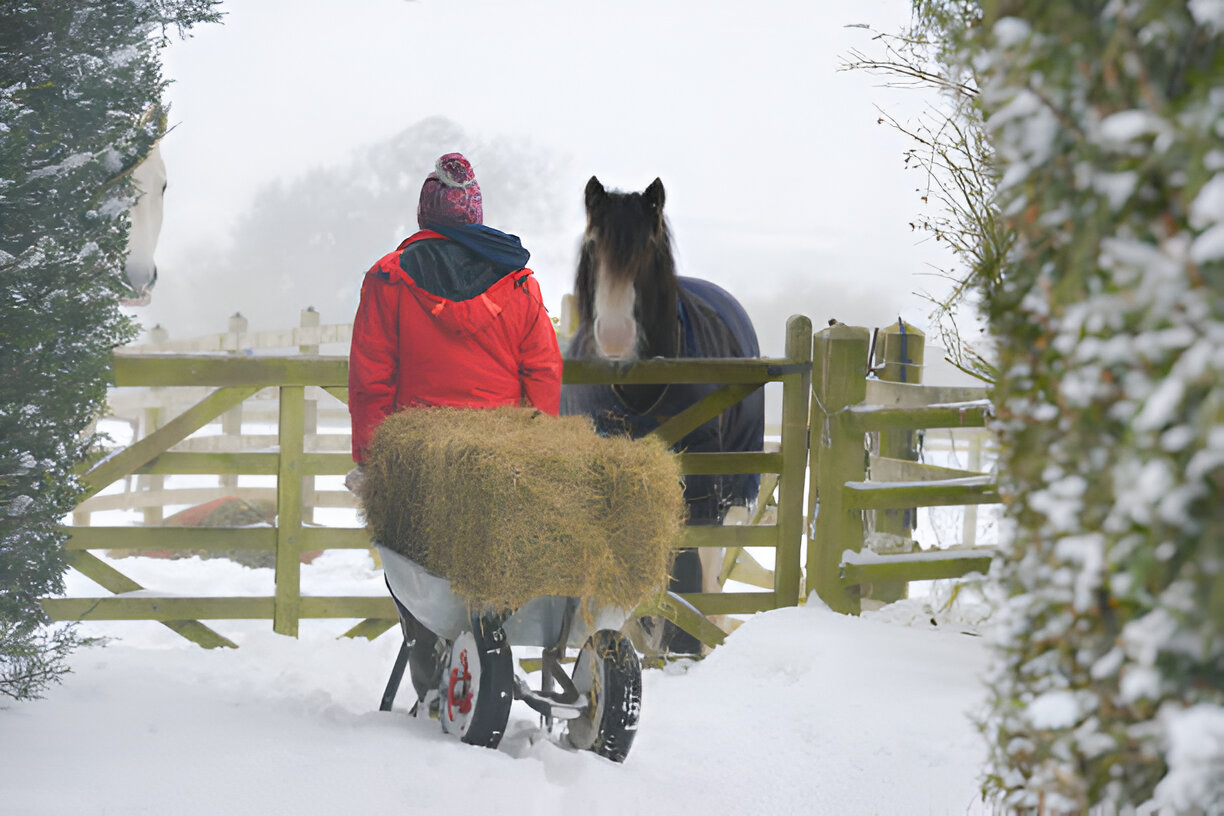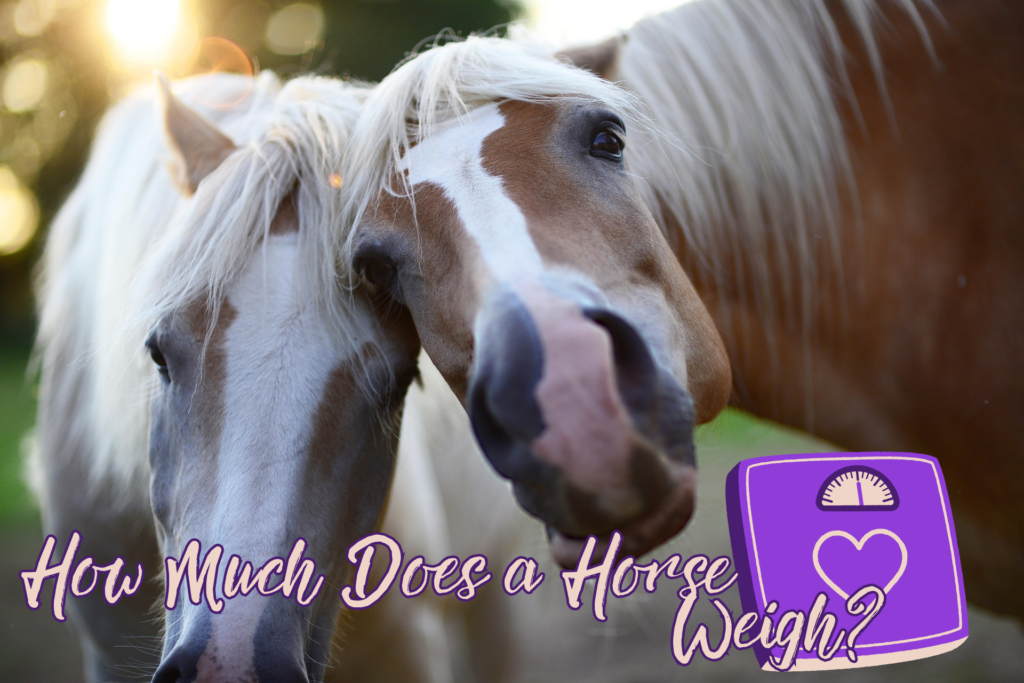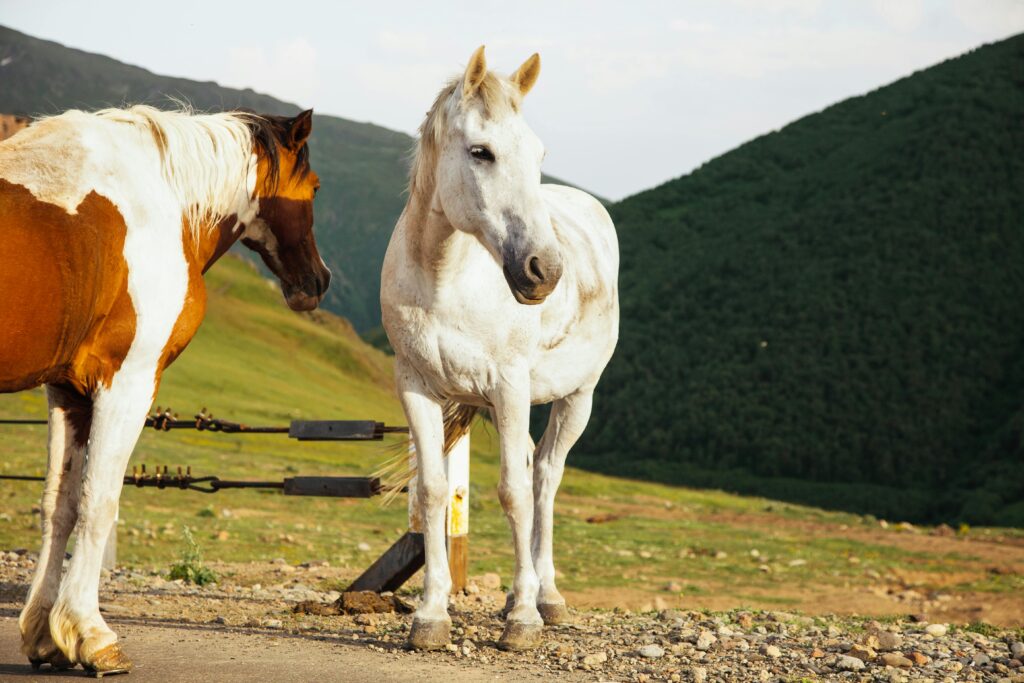Feeding Your Horse in Winter: Keeping Them Warm and Healthy
What should be fed to your horse in the winter to keep them warm ?
As winter sets in and temperatures drop, it’s essential to adjust your horse’s diet to ensure they stay warm, healthy, and comfortable. Horses are naturally built to handle cold weather, but providing the right nutrition can help them cope with the challenges of winter.
Increase Hay Intake
In cold weather, horses require additional calories to generate body heat and maintain their core temperature. Hay plays a crucial role in meeting these increased energy demands. Not only is hay an excellent source of fiber, but it also helps promote internal warmth through the process of fermentation in the horse’s hindgut. As hay is digested, microbial fermentation produces heat, which acts as a natural internal heater for the horse. This makes hay an essential component of a horse’s diet during colder months.
Why Hay is Important in Cold Weather
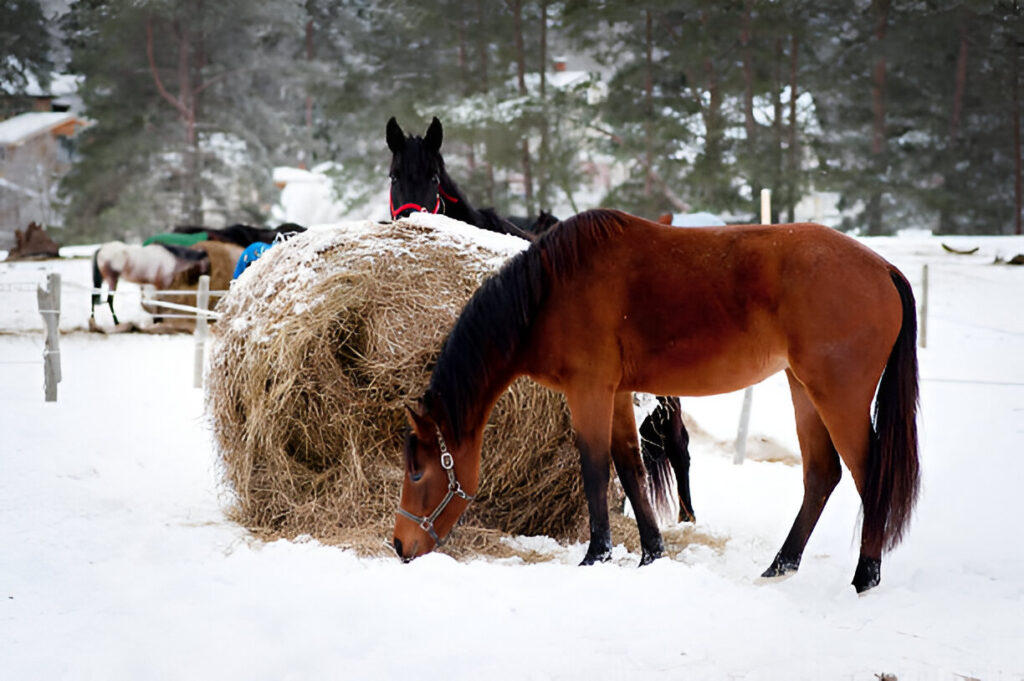
- Caloric Needs: Horses burn more calories in cold weather to stay warm, especially if they are exposed to wind, rain, or snow. High-quality hay provides the necessary energy to meet these increased demands.
- Digestive Warmth: The fermentation of fiber in the hindgut generates heat, helping horses maintain their body temperature more effectively.
- Forage Availability: In winter, pastures often lack sufficient grass, making hay a critical substitute to ensure horses receive adequate nutrition.
Types of Hay
- Grass Hay: Such as timothy, orchard grass, or brome, is a good option for most horses. It provides balanced fiber and is lower in protein and calories compared to alfalfa.
- Alfalfa Hay: Higher in protein and calories, alfalfa is ideal for horses with higher energy requirements, such as working horses, seniors, or those needing to gain weight. However, it should be fed in moderation to avoid excess protein intake.
How Much Hay to Feed
A general guideline is to offer 1.5 to 2% of your horse’s body weight in hay daily. For example, a 1,000-pound horse should receive 15 to 20 pounds of hay per day. During cold weather, this amount may need to be increased, especially if:
- The horse is living outdoors with limited shelter.
- Temperatures drop significantly, or there is wind chill.
- The horse is older, younger, or at a leaner body condition that decreases his heat-regulating abilities.
Winter Tips on Feeding Hay
- Gradual Incrementation: It is a very important precaution; increase hay progressively in small amount, without letting the digestive upsets build inside him. So he becomes tolerant of taking lots of hay gradually.
- Feedings Spread Over The Day: Give smaller, frequent feeds, spread through the day so digestion occurs almost constantly.
- Use Slow-Feed Methods: Hay nets or slow feeders can help extend feeding time, reducing boredom and preventing overconsumption in a single sitting.
- Monitor Body Condition: Regularly assess your horse’s weight and adjust hay intake as needed. A horse in good body condition will have an easier time staying warm.
- Ensure Access to Water: Adequate water intake is essential for proper digestion of hay. Horses are less likely to drink cold water, so consider offering warm water or using heated water buckets.
Special Considerations for Outdoor Horses
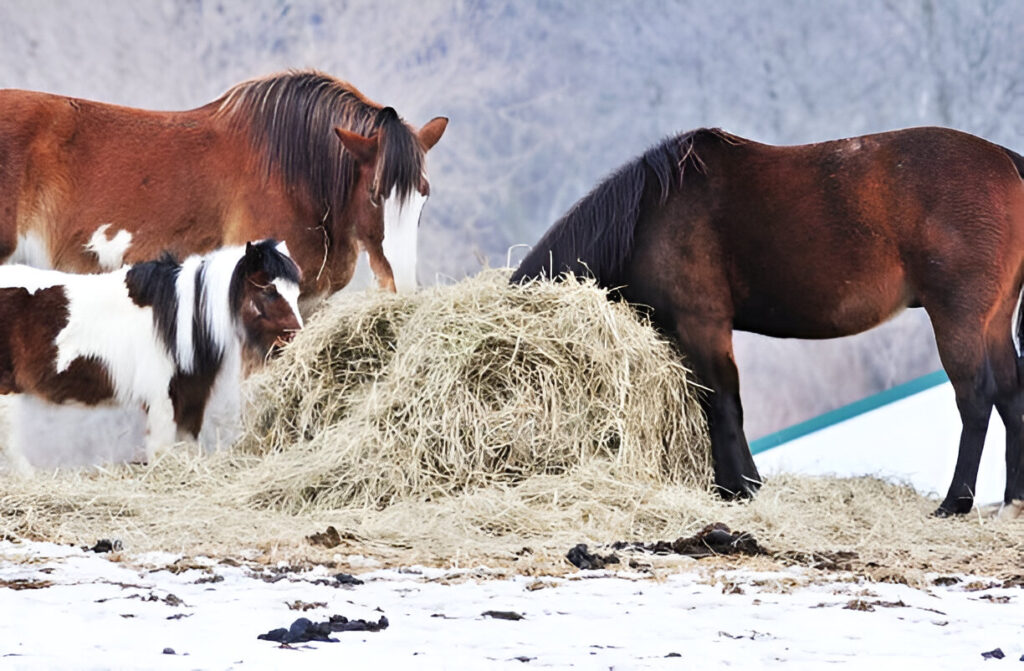
If your horse spends extended periods outside, they will require even more hay to compensate for the additional energy expended to stay warm. Provide hay in a sheltered area to protect it from moisture and ensure your horse has access to it throughout the day. Additionally, consider using hay feeders to minimize waste and keep the hay off the ground.
Provide Adequate Grain
While hay serves as the foundation of a horse’s winter diet, many horses require additional calories to meet their heightened energy needs during colder months. Grain can be a valuable supplement to provide these extra calories, especially for horses with higher energy demands due to work, age, or body condition. However, it’s essential to approach grain feeding carefully, as overfeeding or improper use can lead to digestive issues such as colic or laminitis. Consulting with a veterinarian or equine nutritionist is the best way to determine the appropriate type and amount of grain for your horse.
Why Grain is Important in Cold Weather
- Increased Energy Needs: Cold weather increases a horse’s caloric requirements, as they burn more energy to maintain body heat. Grain is a concentrated source of calories that can help meet these needs.
- Support for Active Horses: Horses in regular work or training may require additional energy beyond what hay alone can provide.
- Targeted Nutrition: Grain can be tailored to address specific nutritional deficiencies or support horses with special needs, such as seniors or underweight horses.
Types of Grain
- Oats: A popular choice, oats are highly digestible and provide a good source of energy without being too high in starch. They are less likely to cause digestive upset compared to other grains.
- Corn: Higher in calories than oats, corn is useful for horses needing significant energy boosts. However, it should be fed in moderation due to its high starch content.
- Barley: Similar to corn, barley is energy-dense but should be cooked or processed to improve digestibility.
- Commercial Feeds: Many commercially formulated feeds are designed to provide balanced nutrition, including vitamins and minerals, alongside calories. These can be a convenient option for meeting specific dietary needs.
How Much Grain to Feed
The amount of grain your horse requires depends on several factors, including:
- Body Weight: Larger horses generally need more grain than smaller ones.
- Workload: Horses in heavy work or training may require additional grain to maintain energy levels.
- Age and Health: Senior horses, young horses, or those with health conditions may have unique nutritional needs.
- Body Condition: Underweight horses may need more grain to gain weight, while overweight horses may require little to no grain.
A general rule of thumb is to feed no more than 0.5% of the horse’s body weight in grain per meal. For example, a 1,000-pound horse should receive no more than 5 pounds of grain per feeding. Splitting grain into multiple small meals throughout the day can help prevent digestive issues.
Tips for Feeding Grain Safely
- Introduce Gradually: If your horse is not accustomed to grain, introduce it slowly over 7–10 days to allow their digestive system to adjust.
- Balance with Forage: Grain should always be fed alongside ample forage (hay or pasture) to support healthy digestion and prevent issues like ulcers or colic.
- Monitor for Digestive Upset: Watch for signs of discomfort, such as loose stools, bloating, or changes in behavior, which may indicate that the grain is not being well tolerated.
- Avoid Overfeeding: Excess grain can lead to obesity, metabolic disorders, or laminitis. Stick to the recommended amounts and adjust based on your horse’s condition and activity level.
- Provide Clean Water: Ensure your horse has access to fresh, clean water at all times, as grain digestion requires adequate hydration.
Special Considerations
- Senior Horses: Older horses with dental issues may struggle to chew hay effectively. Soaked senior feeds or pelleted grains can be a good alternative to provide necessary calories.
- Hard Keepers: Horses that struggle to maintain weight may benefit from higher-calorie grains or fat supplements, such as rice bran or vegetable oil.
- Easy Keepers: Horses prone to weight gain or metabolic issues may need little to no grain. Focus on high-quality hay and consider low-starch, low-sugar feeds if additional calories are necessary.
Provide Fresh, Clean Water
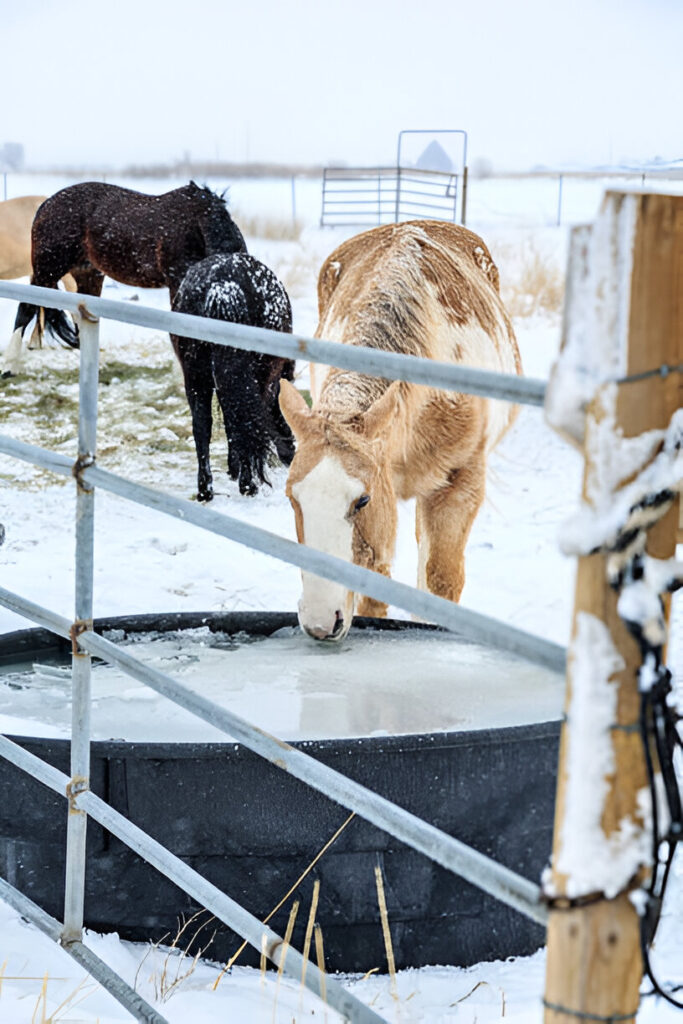
While it is always important to ensure your horse has access to fresh, clean water throughout the year, it is especially necessary during the winter months. Cold weather can reduce a horse’s willingness to drink-increasing the risk of dehydration. Not only will dehydration compromise health, but it also impairs digestion, making it harder for horses to process the increased amount of hay and grain they eat in winter.
Additionally, dehydration can exacerbate the effects of cold weather, as well-hydrated horses are better equipped to regulate their body temperature. To prevent these issues, it’s essential to take proactive steps to keep water sources unfrozen and appealing.
Why Water is Vital in Winter
- Digestive Health: Water is essential for proper digestion of hay and grain. Without adequate hydration, horses are at risk of impaction colic, a common winter concern.
- Body Temperature Regulation: Hydration maintains blood volume and circulation, which are important to keep a horse warm in cold weather.
- Reduced Risk of Dehydration: Horses may drink less in winter because cold water is not as appealing, or because their water sources are frozen. Ensuring access to fresh, unfrozen water encourages regular drinking.
Challenges of Winter Hydration
- Frozen Water Sources: Buckets, troughs, and automatic waterers can freeze in low temperatures, cutting off your horse’s water supply.
- Cold Water Preference: Horses are less likely to drink icy water, which can lead to reduced water intake.
- Increased Hay Consumption: Horses eating more hay in winter require more water to aid in digestion and prevent impaction.
Tips for Providing Fresh, Clean Water in Winter
- Heated Water Buckets or Troughs: Invest in heated buckets or water heaters specifically designed for livestock tanks. These keep the water at a comfortable temperature, so freezing is not an issue and encourages horses to drink.
- Check Water Sources Frequently: Even with heaters, check water sources multiple times a day to ensure they are working properly and haven’t frozen over.
- Offer Warm Water: If possible, provide slightly warm water to make it more appealing. This can be especially helpful for older horses or those with dental issues.
- Insulate Water Containers: Use insulated buckets or wrap troughs with insulating materials to slow down the freezing process.
- Break Ice Regularly: If you don’t have access to heated equipment, break ice on water sources several times a day to ensure your horse can access liquid water.
- Increase Salt Intake: Adding a small amount of salt to your horse’s diet can encourage them to drink more water. Provide a salt block or mix loose salt into their feed.
- Check Water Intake: Monitor what your horse drinks. The ideal water consumption per day should lie between 5 to 10 gallons. All this depends on factors such as body size, feeding, and degree of activity. Insufficient intake will point out or may result from dehydration and related conditions.
Warning Signs of Dehydration
- Dry Mucous Membranes: Check your horse’s gums; they should be moist and pink. Dry or pale gums can indicate dehydration.
- Skin Tent Test: Pinch a fold of skin on your horse’s neck. If it takes more than 2–3 seconds to return to normal, your horse may be dehydrated.
- Reduced Urination: Dehydrated horses produce less urine, which may also appear darker in color.
- Lethargy or Poor Appetite: A dehydrated horse may seem sluggish or lose interest in food.
Special Considerations
- Outdoor Horses: Horses living outside are more susceptible to frozen water sources. Ensure they have access to heated or insulated water containers and check them frequently.
- Senior Horses: Older horses may have difficulty drinking cold water due to dental issues or arthritis. Offering warm water can make a significant difference.
- Traveling or Competing: If you’re traveling with your horse in winter, bring along a thermos of warm water to encourage drinking during stops.
Add Healthy Fats
To help your horse maintain body temperature, you can introduce healthy fats like vegetable oil, corn oil, or rice bran to their diet. Fats are a concentrated energy source, which is perfect for the winter months when extra calories are needed. However, be careful not to overdo it, as excess fat can lead to weight gain or digestive issues.
Consider a Winter Supplement
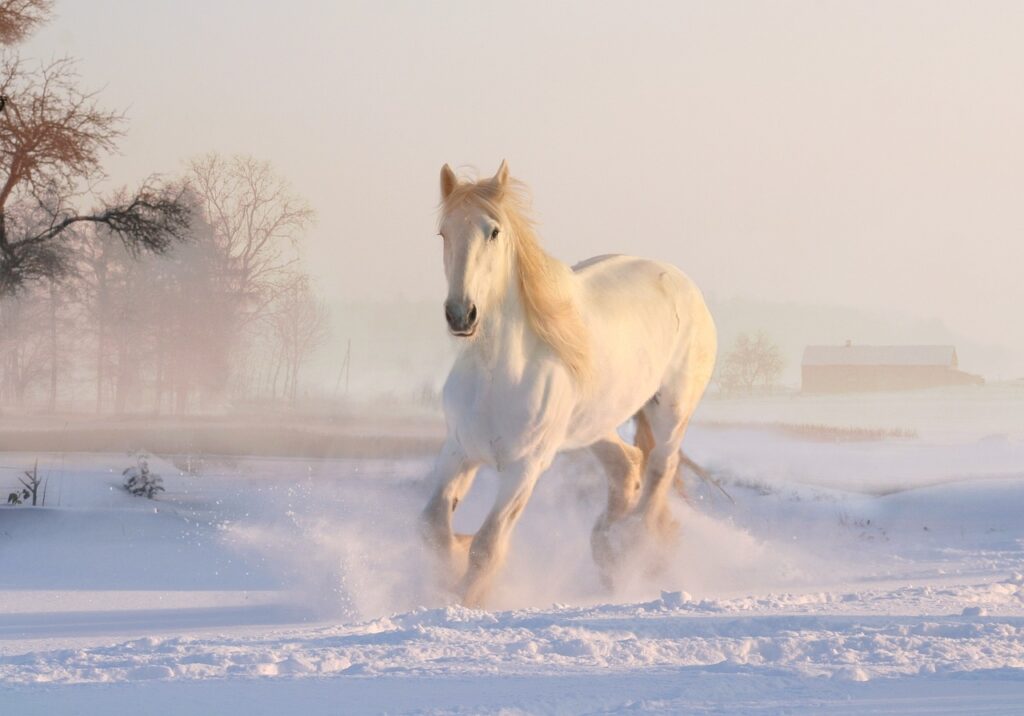
Image by Dorota Kudyba from Pixabay
If your horse’s coat isn’t as thick as it should be or if you’re concerned about their overall condition, adding a winter-specific supplement might help. Omega-3 fatty acids, for example, promote coat health, while vitamins and minerals like Vitamin E and selenium can help boost immunity during the cold months. Always consult your veterinarian before adding supplements.
Monitor Their Body Condition
Winter feeding should be tailored to your horse’s needs. Some horses are naturally more inclined to gain weight in winter, while others will lose it. Always check their body condition and adjust feed levels accordingly. The general rule is that your horse should be slightly heavier in winter compared to summer, since extra fat serves as an insulating layer.
Exercise and Shelter
While feeding is key to keeping your horse warm, exercise and shelter are also crucial in the winter months. If possible, allow your horse to exercise regularly. This increases circulation and helps with heat production. Additionally, make sure they have access to shelter from wind, snow, and rain.
Conclusion
Feeding your horse during the winter requires extra attention to detail. With proper hay, grain, water, and the right supplements, you can help ensure your horse stays warm and healthy throughout the colder months. Always remember that every horse is different, so be sure to monitor their body condition and adjust their diet based on their individual needs. By taking these steps, you can keep your horse comfortable and thriving, even in the harshest winter weather.
Yuns Legdm is a passionate advocate for pet care and the founder of this website, dedicated to providing valuable information for fellow pet lovers and veterinary professionals worldwide. With a deep love for animals, Yuns created this platform to connect passionate pet owners with expert insights from veterinarians around the globe.
This website grows with you—the passionate pet owners and veterinary experts—creating a trusted space where knowledge, experience, and love for animals come together. Whether you’re seeking advice on pet health, nutrition, or general well-being, this platform is here to support you on your journey of responsible and loving pet care.

